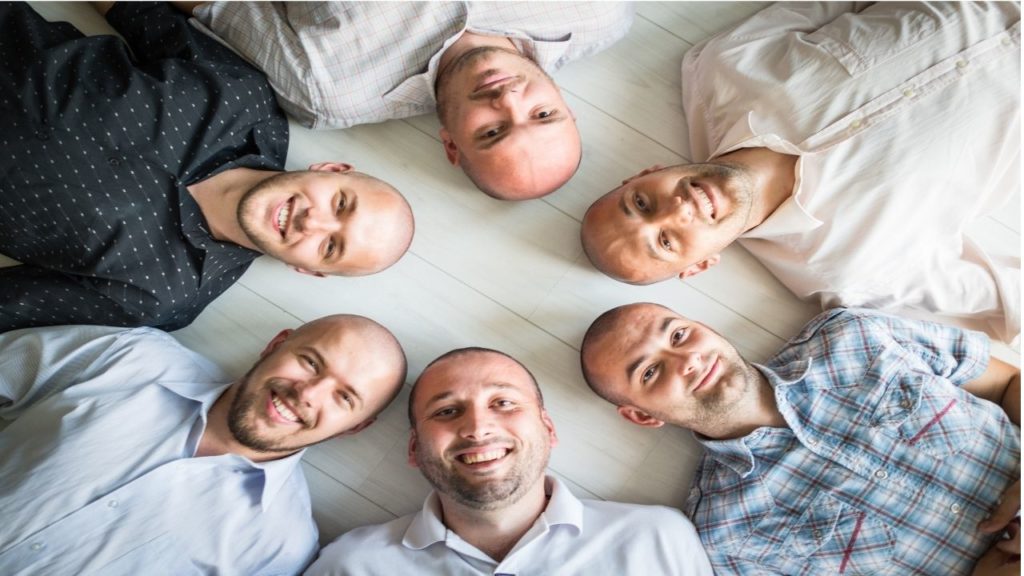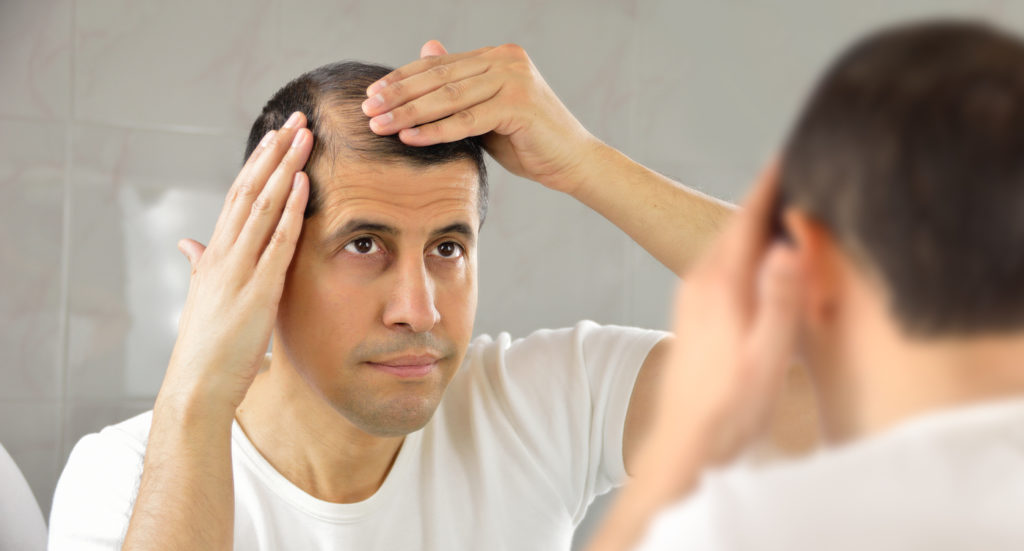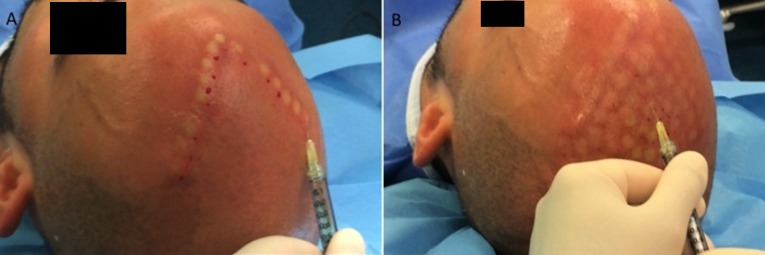The Best Treatments for Men’s Hair Loss, According to a Leading Dermatologist
Here’s the bald truth.
If you’re anything like me, you’re pressing your hair follicles against the mirror each night and examining them for signs of hair loss. And if you’re even more like me, you’ve acknowledged a change in hair growth patterns over the years, but are unwilling to accept the reality of this less-than-ideal, yet inevitable situation.

“With hair loss in general, a lot of people are in denial at first,” says N.Y.C.-based dermatologist Dr. Robert Finney of Entiére Dermatology. “But if you notice thinning, chances are likely that nearly 50 percent of the hair is already lost in that area. The earlier you treat it, the better.”
Luckily, there are a variety of treatments, both new and old, to revitalize your suffering scalp and promote the maintenance and re-growth of those once-luscious locks. I chatted with Dr. Finney, one of the country’s leading hair loss experts, to share his recommendations, misconceptions, and general knowledge when it comes to the popular condition, which will affect more than 80 percent of men in their lifetime.
The Causes of Men’s Hair Loss
Before delving into remedies, it’s important to understand the root (pun intended) causes of most men’s hair loss. (And no, the old wives tales about skipping generations and mirroring your maternal grandfather’s hair status are not true.)
Hair loss can be broken up into two different categories; the first being telogen effluvium, which is a term often used synonymously with “stress-related.”
“Sometimes stressors like the loss of a family member, hospitalizations, and illnesses (hello Covid), as well as medications and medical conditions like thyroid disorders can cause shedding. This shedding occurs all over the scalp, unlike genetic hair loss which tends to start at the temples and crown on men,” says Finney. The encouraging news is hair loss due to stress is not permanent and will return on its own, but can be re-grown quicker with the use of treatments.
The other is genetic, which is completely out of your control and embedded in your DNA. “If you’re shedding in specific areas [like the crown or hairline], it’s more likely genetic,” he adds. Unlike stress-related hair loss, there is no way to predict or prevent the inevitable from happening altogether. You can, however, proactively slow the hair you have left from falling out and encourage regrowth.

Is It Impossible To Prevent Men’s Hair Loss?
Despite what fancy shampoos, conditioners, supplements, and serums may promise, genetic hair loss is not preventable.
“There are no true preventative methods,” asserts Finney. “If your hair is going to fall out from genetic hair loss, no shampoo is going to make that better. Some hair loss shampoos do have active ingredients to help fight hair loss, but they are nowhere near as effective as other conventional treatments and often come at a hefty price tag.” Thickening shampoos are also only temporary remedies, leaving behind build-up to give your hair a fuller appearance. The outcome, however, is never permanent.
To get a better sense of where your scalp currently stands, it’s ultimately in your best interest to visit a dermatologist. He or she can use technology to magnify your hairs and identify genetic hair loss in its earliest stages.
“There are ways to detect if a hair is on its way to falling out for good,” says Finney. “It is important to examine the caliber or thickness of a patient’s hair on the back of their scalp, as well as the front and top. If you have ever seen someone who is ‘bald,’ they still have a rim of hair on the sides and in the back between their ears. For whatever reason, these hairs are not susceptible to genetic hair loss. When you start to suffer from genetic hair loss, hairs will miniaturize prior to permanently leaving. If you compare a hair from the crown or temple to one from the back and there is a big disparity in thickness of the individual hairs, this is one of the earliest signs that show genetic hair loss has begun.”
This test will also allow for you and your dermatologist to come up with an action plan, either aggressive or conservative, to combat the unavoidable. While you may not be able to prevent genetic hair loss from happening altogether, you can get a head start to keep what you have and regrow it in different areas. Think of it as “boosting or flattening the curve,” says Finney, but keeping in mind that you’ll have to continue any treatment in perpetuity for long-lasting results.
For anyone who isn’t sure about whether or not their hair is thinning, Finney recommends taking photos three to six months apart. If you notice a significant difference, it’s time to book that appointment.

The Best Treatments for Men’s Hair Loss
Whether you’re suffering from stress or genetic-related hair loss, the treatments range from over-the-counter to more invasive. No matter what route you and your doctor choose to take, it’s important to understand, at least with genetically-induced conditions, that once you stop any treatment, the regrowth also stops and your remaining hair will continue to fall out.
“A common misconception is that people think there is a one-time deal,” says Finney, who claims that it can take up to three to four months before seeing any type of significant improvement. “You have to continue any treatment for as long as you want it to work for you.”
Minoxidil
A topical like minoxidil, the active ingredient in products like Rogaine, is a fantastic place to start. Not only is it “extremely well-tolerated” and effective, it’s also inexpensive and readily available.
“We don’t know the full reason why Rogaine helps with both kinds of hair loss, but they [both stress and genetic] respond to it,” says Finney. To take full advantage of its efficacy, you’ll want to apply the topical solution at least once a day and all over the top of the scalp for genetic hair loss or the entire head for stress-related hair loss.
“Short contact treatment doesn’t work,” he adds. “It’s similar to a face treatment for acne. A face wash is all good and well, but if you have acne and all you’re doing is an acne face wash, you’re not going to see great results. You really need to leave on products that make contact with the skin for a while in order to see real change.”
For those who require higher doses, prescription-strength options are also available. Otherwise, the standard five percent concentration should work for most patients. Some dermatologists may also customize topical prescription solutions that contain higher doses of minoxidil with topical forms of finasteride and something to increase the penetration of the active ingredients, such as tretinoin (Retin-A).
Platelet-Rich Plasma Injections (PRP)
This tried-and-true therapy requires the drawing of your own blood that is then put into a centrifuge to yield platelet-rich plasma. These platelets are packed with growth factors that are released upon injection to help fight hair loss. They have been shown to thicken the caliber of existing hairs, regrow new ones and keep hairs in the growing phase for longer. “It can be helpful on its own or in conjunction with other treatments,” says Finney.
The benefits of PRP are that you don’t have to do anything at home and after your initial three monthly treatments, maintenance is typically only needed once every four to six months. It’s also an ideal option for those who want a more natural, holistic approach to hair restoration since it’s your own blood product going into your scalp and not an outside ingredient.
Finasteride
Both topical and oral, finasteride (typically known as Propecia) has long been touted as one of the most successful hair growth options. It’s generally well-tolerated, however, a small percentage of males report sexual side effects like decreased semen, erectile dysfunction, and reduced sexual desire. This has deterred many men from taking it in pill form, though Finney argues that if these symptoms are experienced, they typically return to normal upon stopping the medication.
The difference between finasteride and minoxidil is that the former has proven to block a version of testosterone, dihydrotestosterone (DHT), that causes hair loss. Minoxidil’s exact mechanism of action is still not clearly worked out. When used conjunctively, the dynamic duo is said to promote substantial hair growth by attacking hair loss from different angles.

Low Level Laser Light Therapy
“Laser caps and laser combs can work, as well, but they are often less helpful than other treatments, so I tend to talk about them last because most people go for other options,” says Finney.
Surgery
Going under the knife for a transplant is certainly an alternative, but not one that Finney recommends right away.
“The donor area—think the area of hair that Seinfeld’s George Costanza still has populating his scalp—is the reservoir of ‘safe’ hair to transplant,” he says. “If you took that hair and tried to transplant it onto the top of the scalp, you could run out of hair that gives the appearance of a full head of hair. ”
Instead, Finney encourages patients to be placed on a treatment plan (using the aforementioned options) to help hold onto the hair you already have prior to considering surgery in most cases.
Nutrafol and Other Hair Loss Supplements
“Nutrafol and other hair vitamins don’t tend to work that well,” says Finney. “They’re also very expensive.”
One common ingredient, saw palmetto grass, is a weak DHT blocker and nowhere near as effective as finasteride, according to Finney. “A lot of these hair vitamins also carry really high doses of biotin.”
“More and more data has come out in the past five years that shows if you’re taking much more [biotin] than what’s needed in our diet, it can actually throw off testing to make your bloodwork show you have an issue,” he warns. “The chances of you being deficient in a vitamin that’s contributing to hair loss is extremely low.”
Which Men’s Hair Loss Treatment Is Right For You?
Since genetics are the biggest contributor to hair loss and everyone is at different stages, it’s important to meet with a dermatologist or skilled hair loss medical expert who can come up with an individualized plan. This may involve a single treatment or combination therapy, but it’s equally as important to understand that results won’t happen overnight and that once you start, you really shouldn’t stop.
“Your hair is constantly cycling,” says Finney. “If you do something that flattens that curve and keeps you stable and then you stop it, you’ll notice a lot of hair loss over the next six months. But those are hairs that were going to be gone anyway, so it’s not like you’re worse off. You’ll feel that way, but treatment is just holding on to hairs and delaying time for you. You have to be consistent.”
Loading...